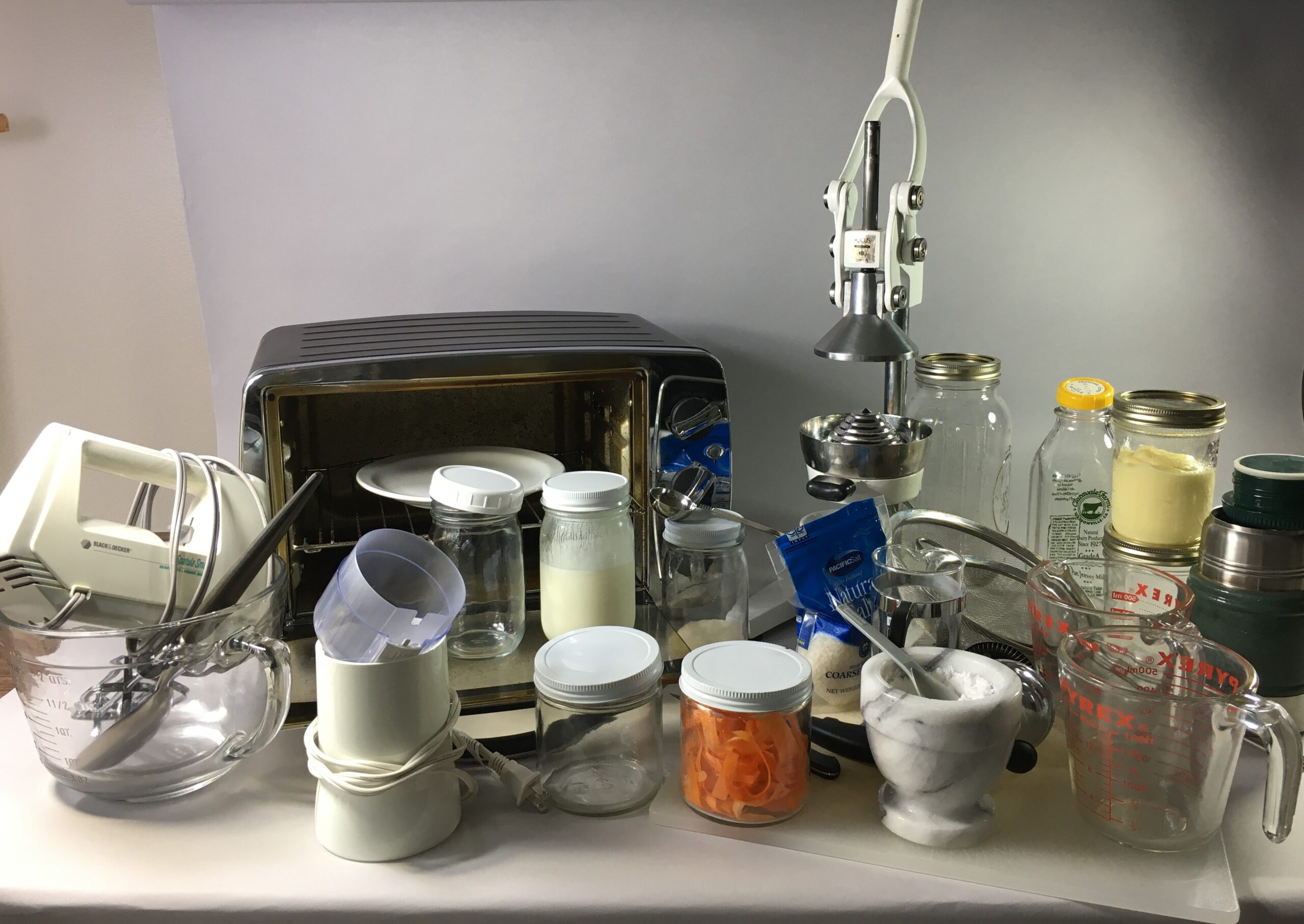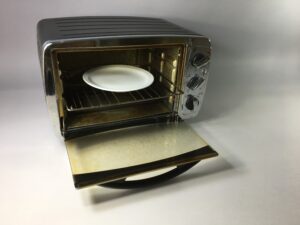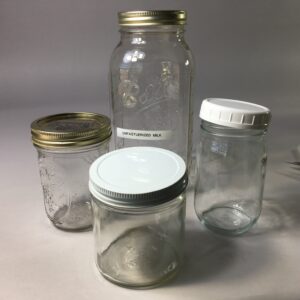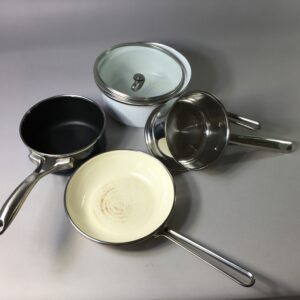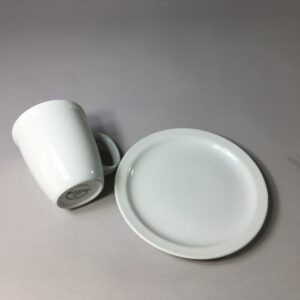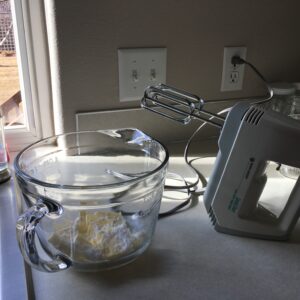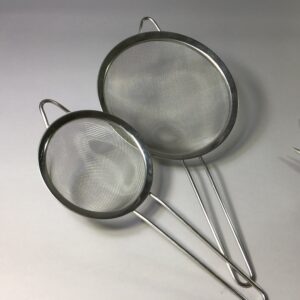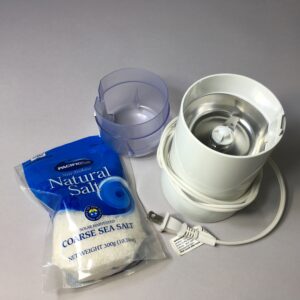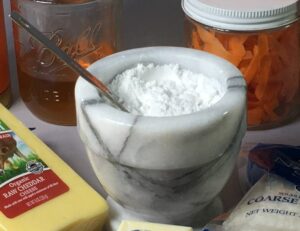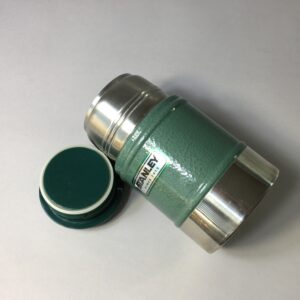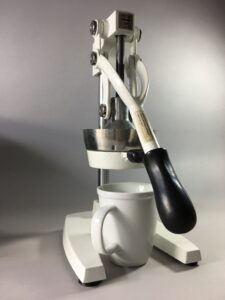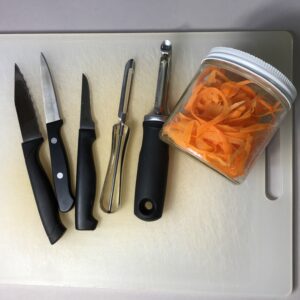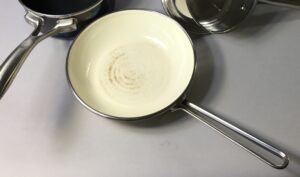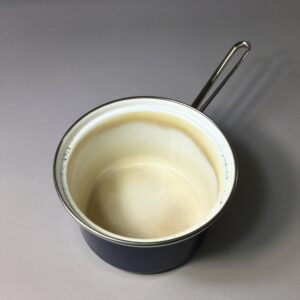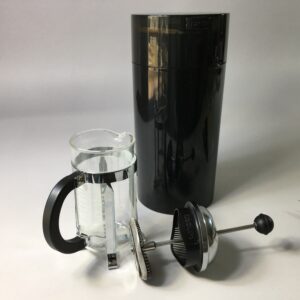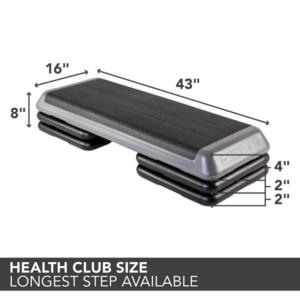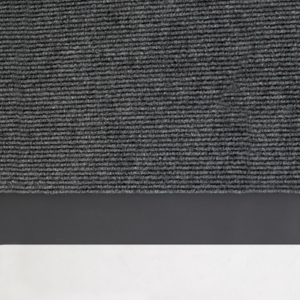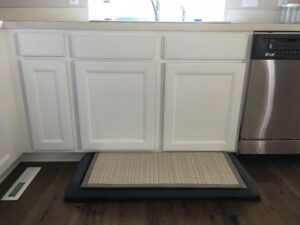These are the tools used and mentioned in the real food section.
The tools you will need are common to most kitchens. And you don’t need many!
Please do not use a microwave oven for anything. They completely change the molecular structure of anything—food, water, anything put through it.
I use a small toaster oven for nearly all my needs, including cannabis preparations. You will want one with INSIDE measurements that are about 8”-9” HIGH by 10-11” wide and deep. The low 5-6” tall inside measures of some of the units will not accommodate the temperature probe in the cannabis decarb box you will need for your cannabis preps.
When purchasing a toaster oven, I suggest buying it in person and taking your tape measure with you. From the rack being in the lowest position to the heating element on the top, you want about 6-1/2 inches to 7 inches clearance or the decarb box with the temp probe will not fit correctly.
This toaster oven does NOT need to have convection cooking options. It does need a variable temperature capability. The lower end, simple setup and lower price is just fine and what I use.
I use glass for everything I can including for storing pre-made carrot shavings salad, once-a-week prepared daily potatoes, milk stored into 2-cup jars from the half gallon of it brought home from the farm so it’s more usable on a day to day basis. I break down the container of dry gelatin into the jars so they are easier to scoop, etc..
All plastic, plastic carbonate, all of it leeches chemicals into your food. Try your best to de-plastic your cookware.
I confess I still have a plastic cutting board used for meat cut-ups as so many of the prep boards out there damage kitchen knives.
I’m experimenting now with a special wood fiber composite cutting board I found that saves knives but it lasts only a few cuts! (And conveniently, the manufacturer no longer makes them).
Acacia and bamboo or maple wood cutting boards help the knives but can contain toxic poisons in the wood treatments and finishes. And they can be heavy if you are older like me, or have arm or hand pain (like me).
You can look for non-toxic, organic cutting boards and coconut oil and beeswax finishes. There is a great deal of care to use with hardwood boards as well as a pricey investment upfront to purchase them.
And there are rubber cutting boards, though they have “anti-microbial finishes”…which who knows if that can come off in food. They are supposed to be non-toxic and NSF certified for safety (but remember, who is minding the store).
And I still use ziplock plastic baggies to freeze-store single servings of raw meat. I have tried to use wax-coated sandwich bags for this, but they leak.
But do what you can.
So again, just do the best you can, we don’t need to be perfect.
For my cookware, I use a vintage, smooth bottom, high-quality real enamel 8” fry pan and a modern enamel 2 quart saucepan (both made by Chantel).
The new modern enamel pans are really heavy as a note. I have a small enamel Staub pan that is too heavy for me to use these days even as it’s only an 8” sauté pan.
HACK: You might find similar older (and lighter-weight) cookware on eBay or Etsy. Look for vintage “Chantel” or “Le Creuset” (though Le Creuset will scratch a glass cooktop… and generally Le Creuset is heavier as it’s enamel over cast iron) under Collectibles or Vintage.
Do NOT use modern “micro-crystalline” or ceramic pans like “Green Pan” as these add toxic chemicals when heated far below the advertised temperature range.
Otherwise use regular STAINLESS STEEL pans or vintage corning ware glass or enamelware pans could also work.
Most of my cookware is high end enamel with one small stainless steel pot for occasionally cooking greens (because cooking chards and kales WILL etch out your enamel pan coatings from the oxalic acid the cooking water is purposely leaching out). See below for more on that.
Aluminum cookware or tools will leech chemicals into your food.
And unless you have an old electric coil stove or a gas stove, cast-iron cookware will scratch your glass stove-tops, as well, it’s far healthier to NOT ingest any iron residues from cooking with cast-iron.
Cast-iron will leach iron into foods (NOT a good thing). Iron builds up in the liver and is never eliminated.
Chelation remedies can be dangerous, releasing the metals and toxins potentially into one’s brain instead of out the body during the process.
So just don’t do it. At some point the iron becomes toxic. Please never take iron supplements of any kind.
Most of my cookware is high end enamel with one small stainless steel pot for occasionally cooking greens.
TOOL List:
Glass water bottle, filled with clean drinking water (like reverse osmosis, RO water) left out near your work area all day so you remember to drink some water all day long.
Toaster oven, small, the inside can be about 11” x 10” or so BUT about 8-9″ high inside.
As mentioned above, when purchasing a toaster oven you will also be using to make your medicine, I suggest buying it in person and taking your tape measure with you. From the rack being in the lowest position to the heating element on the top, you want about 6-1/2 inches to 7 inches clearance or the decarb box with the temp probe will not fit correctly.
Small porcelain pottery plate, oven proof, used to broil meats on instead of using an aluminum pan.
Electric hand mixer and bowl.
A large size and a measuring cup size fine mesh strainers that you will use also for cannabis preparations. Do look at the mesh when purchasing. Many metal or plastic strainers have pores that are too big to properly strain. You can find the fine mesh strainers at the grocery stores, box stores, or cooking stores. They are common but do look in the section for the FINE sizes.
An inexpensive coffee mill or a “Bullet” blender that will be used only to powder salt.
A small bowl to put powdered salt in, with a small scoop spoon (I use a granite mortar bowl)
Various glass jars, from 1/2 gallon size used for transporting raw milk if needed, to pint mason jars, pint jelly jars, cup and a half wide mouth glass jars. These can be acquired from garage sales, relatives/friends, online.
Wide mouth (wide mouth is easier to open and easier to clean) good quality 2-cup Thermos (Stanley is a good brand, it will be used daily). The wide mouth is easier to pour into and easier to clean. It’s also easier for arthritic hands to handle. A high quality thermos does not need the lid hard-tightened down to keep a liquid warm over 12 hours. I only give it a few very gentle, loose twists to close it. Be careful not to knock it over as it will spill.
I have this one except mine is still the 17 oz. size, but this classic wide mouth style, this one is less expensive and would still work just fine for the 16 oz. of melted gelatin. It’ll be taller and bigger than you need.
Hand orange juice press. Unless you have $800 or more for an electric orange PRESS (NOT juicer), the best option is to find online a $100 hand press with a lever. The orange should not be torn apart to juice it. We want pulp free orange juice so it will be pressed and then poured through the small strainer into a glass, daily. The small electric inexpensive masticating juicers pulverize the pulp and membranes and add it to the juice, advertising that this is more nutritious. You don’t want that. Eating that pulp daily can cause hemorrhoids. If your hands have weakness and aches and will not allow you to use such a press, you can alternately look for a centrifugal juicer that doesn’t grind up all the pulp (look for NOT masticating) and then still strain through the hand strainer what is expressed.
Two at least, 2-cup glass measuring cups
Plastic or wooden cutting board
Several small stainless steel or ceramic paring knives
A couple of small wooden stir spoons made out of higher end “food grade” wood like olive wood, hand wash only, do not soak. Like a wooden cutting board, you want your stir spoons to be non-toxic and not flake off pieces of varnish or cheap pine wood into your food from the lesser quality spoons.
Several vegetable peelers that will be used extensively and will wear out sometimes in just months, so I usually purchase in bulk. I like the OXO Pro swivel and several of the inexpensive plain swivel peelers.
Small 8” enamel fry pan, I use this 3 times a day, I have a very old Chantel version. The newer versions are very heavy as is the Staub enamel fry pan. Sometimes you can find an old version of the Chantel on eBay or Etsy or a garage sale.
I have twice, one after another, tried the $100-a-pan, very light weight and high end micro crystalline ceramic fry pans (like the Green Pan series) but in a very short time the coating began to flake off. Both did this. And though rated up to 450 degrees stable, both the pans offgassed some chemicals at low temps that I could both smell and even taste in the food.
A small quart and a half enamel sauce pan. I use a more modern Chantel version.
A 3 quart or so enamel sauce pan. Also Chantel brand from a number of years ago, but no longer made version.
One small STAINLESS STEEL quart and half sauce pan to boil greens like Chard and Kale. Peat said because of the oxalic acid in these greens, they need to be boiled in water for 40 minutes minimum and the boil water discarded.
Oxalic acid is highly corrosive to enamel and I ruined 3 very expensive Chantel pots with just a few boils like that before I discovered this. See the photo! This happened within only about 4 months of use …maybe a dozen times cooking the greens.
Small (2-3 cup) coffee maker. I use a glass Boden French Press and a TightVac coffee air-tight storage container for coffee.
As a heads up, I’ve used this storage container for years but pressing the button and grasping the lid to use it is getting more painful as my hands have progressed in their arthritis. If you have such hands, I suggest looking for a different-opening cannister idea instead. I haven’t yet switched mine out, but will sooner than later.
Other coffee home storage cannister ideas can be found here and here.
A heavy-duty electric hand mixer to make mashed potatoes every week and a glass or stainless mixing bowl. The best quality of these mixers came out during the 90’s. Ebay and Etsy are still abundant with offerings for them.
The one I have (and I actually bought two so I have a spare!) is the vintage Black & Decker Heavy Duty – Power Boost Cat. No. M-175 Type 1 175 W 120 V AC Only. The beaters are still the press-in square metal ones and are incredible for all kinds of mixing and especially for making mashed potatoes.
The modern, 2022 electric hand mixers are more like toys. They often have whips for beaters instead of the sturdy square metal ones, that just will not cut and mash even the softest of potatoes before they break. As well, many versions coat the beaters with a Teflon type material that can flake chemicals into your foods. Do NOT buy these type mixers!
KITCHEN HACKS:
Regardless how tall you are, place your mixing bowl into the sink as you use your electric mixer. It will be easier on your arms, shoulders, and neck to help relieve pain there and in your back as you are reaching downwards instead of upwards. And it will keep any splatter more contained in the sink rather than all over under your kitchen cabinets!
And another ergonomic HACK for the kitchen:
[USE THIS platform Hack ONLY if you have stable BALANCE in general AND you can easily step up and down about 4” multiple times a day without damage or pain.]
But, I use a very sturdy riser in the kitchen that I can stand on to relieve back and shoulder pain as you work around the sink and countertops. IT MUST BE WIDE ENOUGH BOTH WAYS.
You don’t want to balance or stand on anything wobbly, too high, too narrow or a step stool. You want a platform you can move around that’s only about 4” off the floor.
I found one of those $80 platforms of 43” x 16” plastic that’s an exercise platform called The Step Original aerobic exercise platform, “Health Club Size” to be perfect and cost effective.
I placed mine on a mat made of a piece of thin, clean/new ridged garage mat style mat from the Home Depot or Lowes. You can even have them cut it to size to just fit under the plastic feet of the platform.
Unless you have a tile kitchen floor, you will want the mat under the platform also, since in my opinion the plastic feet of the platform mar the kitchen floor a bit.
The mat also adds more stability.
Turn the mat up-side-down so the pile rug is upside down on the floor, and the plastic underside of the mat is on top. Place the platform on it that way on top of the plastic bottom of the mat.
Unless on rough tile, I find I can easily slide it all back and forth if I’m working at another section of countertop.
I discarded the two extra 2” risers. The 4” of the main body fits neatly under my lower kitchen cabinets so they still open nicely. And the platform is low enough for me to step up and down with pretty good ease.
I place a padded kitchen sink rug over the top on the platform that’s cushy to stand on and resists splashes.
It lifts me 4” more over my work area—just soooo saving my arms and back and neck to do peeling work, or the mashed potatoes mixing (with the bowl still IN the sink!).
And I guess I get a bit of extra “Step” workout going on and off it! This would definitely count as some of your daily Movement!
It sits in front of my kitchen sink and extends a bit out on either side. I can easily move around and back and forth on it, or easily slide it over a bit if I want to have it more in front of a particular counter space.


